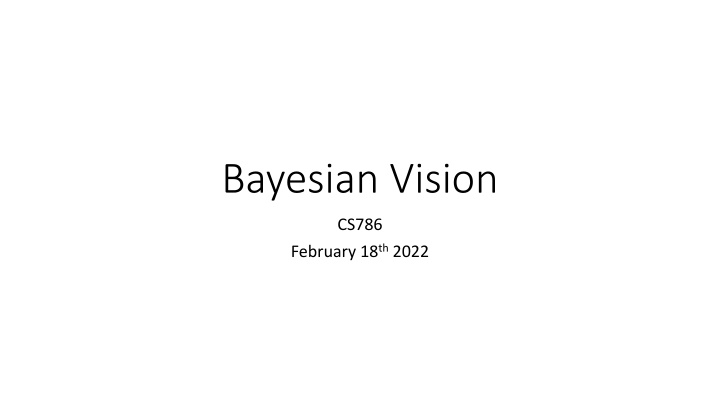
Bayesian Vision and Visual Perception Revolution
Explore the Bayesian approach to visual perception revolution, where vision utilizes more information than what impacts the retina. Understand how Bayesian analysis is used to estimate visual priors and how Bayes' theorem helps in hypothesis testing based on data.
Download Presentation

Please find below an Image/Link to download the presentation.
The content on the website is provided AS IS for your information and personal use only. It may not be sold, licensed, or shared on other websites without obtaining consent from the author. If you encounter any issues during the download, it is possible that the publisher has removed the file from their server.
You are allowed to download the files provided on this website for personal or commercial use, subject to the condition that they are used lawfully. All files are the property of their respective owners.
The content on the website is provided AS IS for your information and personal use only. It may not be sold, licensed, or shared on other websites without obtaining consent from the author.
E N D
Presentation Transcript
Bayesian Vision CS786 February 18th2022
http://www.psych.nyu.edu/maloney/MamassianLandyMaloney.MITPress2003.pdfhttp://www.psych.nyu.edu/maloney/MamassianLandyMaloney.MITPress2003.pdf
Vision uses more information than impacts the retina What you see isn t exactly what you get
Perception as inference Want to know , get to see
Bayesian visual perception Observer constructs p( | ) using p( | ), physiologically determined likelihood p( ), visual priors on percepts Bayesian revolution in perception (Knill, 2004) Using Bayesian analysis to estimate visual priors using behavior responses
Bayesian prior estimation Regular sequential Bayes Update prior by multiplying with likelihood Obtain posterior Use posterior as prior for next time step Inverse procedure Know posterior distribution given all data Divide posterior by data likelihood sequentially Each obtained prior serves as posterior for earlier time step Finally left with original prior
Bayes 101 P(H|D) proportional to p(H)p(D|H) Basic Bayes claim We have a bunch of data D And there are several possible h that can potentially account for the data With a Bayesian analysis, we can construct a probability p(H|D) Which hypothesis is most likely, given we ve seen the data D
Sequential Bayes 101 Let s assume that the data are sequential D = {d1, d2, .. dn} P(H|D(1:n)) proportional to p(H|D(1:n-1))p(dn|H) Prior is p(H|D(1:n-1)) Likelihood is p(dn|H)
Bayesian analysis P(H|D(1:5)) 1,2,4,8,16 . All natural numbers All powers of two Members of the table of two d6 = 31 P(H|D(1:6))
Bayesian parameter estimation Typically hard to obtain likelihoods for multiple sequential updates in closed form Alternative procedure Generate posterior distributions using different parameters determining the prior Find parameters that yield posterior distributions that best fit the true distribution Frequently have to use some form of MCMC sampling
Demo String of binary observations modeled using binomial likelihood and beta prior Posterior update Prior estimation
Applied to vision data Narrow score = proportion of times image is described with bulging narrow ridges http://www.psych.nyu.edu/maloney/MamassianLandyMaloney.MITPress2003.pdf
Simplifying assumptions Response proportions assumed to reflect posterior probability p(narrow|image) Prior biases assumed to influence response independently Model illumination and viewpoint as drawn from a normal distribution on the respective angles
Findings Illumination angles are a priori assumed to be above and to the left Increasing shading contrast reduces the variance of the illumination prior Increasing contour contrast reduces the variance of the viewpoint prior In other experiments, shown that People think they are looking at objects from above People think angles are a priori likely to be right angles And many more
What does it mean? Bayesian models of visual perception give us a way of describing the priors that people use But they don t explain how the priors come to be the way they are Positives: can describe both perceptual and cognitive priors Negatives: Hard to characterize the true provenance of empirically determined priors
